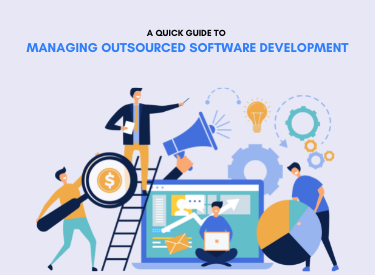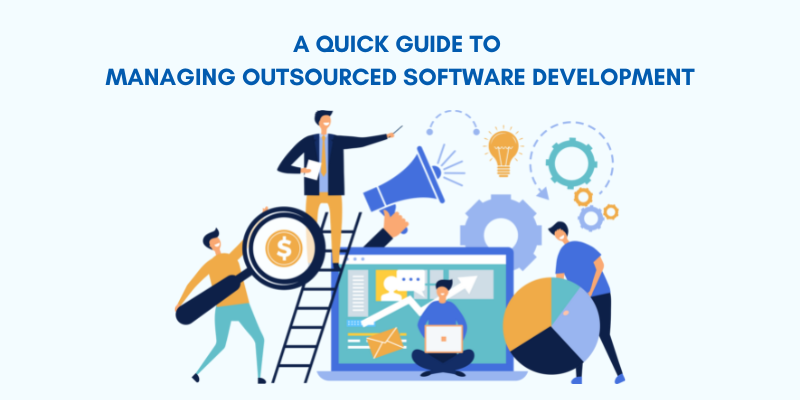A Quick Guide to Managing Outsourced Software Development

IT projects fail for various reasons, but success stories all have one thing in common: a well-thought-out approach for managing outsourced software development teams.
Proper management, among other things, provides efficient resource allocation, maximizes production, and reduces time to market. These are significant advantages, given that cost reduction is the primary reason firms choose to outsource.
An intelligent management plan begins with selecting an outsourcing model that will make it easier for the project manager to keep on top of things. The extended or dedicated team model often gives you the most control over outsourced developers and gives you a good understanding of their roles.
That said, there is a lot more that goes into managing outsourced software development.
In this article, we will look at some of the key issues involved in running a successful dedicated team. We also offer advice on how to get the most out of your outsourcing relationship.
Let’s get started!
5 Tips for Managing Outsourced Teams
We’ve learnt many lessons the hard way over the years, so you don’t have to, such as the following dos and don’ts for managing outsourced software development teams:
1. Communicate Your Plans Clearly and Frequently
Clear and frequently communication is the most critical tool in a project manager’s inventory.
One element frequently ignored here is the significance of presenting the big picture for distant team members (rather than focusing on short-term goals and particular tasks). Like your in-house personnel, you should offer them ample context, ensuring that outsourced teams understand the project requirements and your outsourcing relationship expectations.
You may want to share the following information:
- Your project’s overall vision
- Any related long-term projects in the works
- Indicators of key performance (KPIs)
- Your short-, medium-, and long-term company objectives
It is also critical to communicate frequently and regularly to get everyone on the same page. Outsourced developers should work in tandem with your in-house team and involve them in all communication channels, daily meetings, standups, etc.
2. Extend Your Workflows and Best Practices
Another important part of good communication is introducing the devoted team to all internal resources and workflows that they will require in their work, such as:
- Your technology stack
- Programming tools and processes
- The post-production environment
- Coding best practices
- The design patterns your teams use
- Internal documentation and self-learning resources
A solid rule of thumb is always to explain your software development process in detail. Assume that your in-house and remote teams will have different work styles, even if the outsourced engineers are from a neighbouring nation.
3. Make Collaborative Work and Knowledge Sharing Possible
One of the most significant advantages of outsourcing is collaboration. When your remote and in-house teams collaborate, you can design and deliver high-quality solutions faster and at a reduced cost.
You can foster a collaborative culture and encourage developers to contribute their technical expertise by:
- Company-wide and team events
- Informal knowledge-sharing sessions
- Peer programming
- Peer reviews
- Regular check-ins with developers
- Regular feedback loops
- Consider establishing a dedicated communication channel or library where internal and external teams can access educational content.
4. Leverage Your Outsourcing Partner’s Support Structures
Some software development outsourcing firms provide support services to assist you in getting the most out of your outsourcing relationship and expanding your business.
For example, at Bestarion, we have a dedicated account manager available to answer all of your inquiries, resolve any problems you may have, facilitate contact with the remote staff, and more.
If your vendor provides similar services, make full use of them to ensure a mutually positive and fruitful long-term relationship with your outsourced developers.
5. Consider remote developers to be part of your in-house team.
When your dedicated team members feel welcomed and valued as an integral part of the organization, they are considerably more likely to get personally invested in your company’s success and in assisting you in meeting your strategic objectives.
This is especially crucial in larger firms, which can sometimes feel impersonal and struggle to instil a genuine sense of connection among remote personnel. Collaboration, regular communication, and an inclusive atmosphere are critical to preventing this.
Choosing the Best Outsourcing Partner for Software Development
Managing outsourced software development teams may appear to be difficult, but the good news is that you don’t have to do it alone if you select the correct partner for your needs.
If you’re at this point in your outsourcing journey, here are a few pointers to help you choose a reliable vendor:
Determine Which Outsourcing Model Best Suits Your Needs
This is mainly determined by your budget and project specifications. Offshoring is frequently the most economical option for clients in Western Europe and North America. Onshoring is the most expensive, and nearshoring falls somewhere in the middle. Offshoring works best for simple projects that do not require a lot of supervision. Nearshoring and onshoring are better suited for complicated, long-term projects requiring close collaboration with your internal staff.
Make a list of eligible vendors.
Use your professional network and internet tools like LinkedIn and Glassdoor to limit your possibilities to 5-10 outsourcing providers who appear to be a good fit. Relevant industry experience, case studies or success stories, third-party honours or certifications, and customer and employee reviews are all things to look for.
Conduct interviews with the best candidates.
It is important to ask whether they have worked on similar software projects and whether they are ready (and able) to adjust their services to your company’s needs. You should also make sure that their developers have the necessary competence. Don’t forget to inquire about the payment structure (see our perspective on fixed-price vs time-and-materials contracts) and the developer’s hourly rate.
Choose the Best Fit and Establish a Long-Term Relationship
When you’re ready, select an outsourcing partner who is adaptable and cooperative and who can provide the technical competence and cultural fit you require. Then, devote enough time and money to developing a successful long-term partnership.
Managing Outsourced Software Development with Bestarion
Managing outsourced software development should not divert time and attention away from more important tasks. You have more essential things to worry about, so why not delegate responsibility for your remote engineers to us?
For our clients, we presently manage 30+ specialized development teams. Bestarion understands what it takes to establish successful processes and long-term relationships to support your digital transformation.

